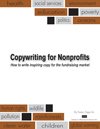Last Friday I wrote a post with a similar theme: Get Your Nonprofit Ready for 2011. Well, this post is inspired by an article today on MarketingWeb, “11 brand and marketing trends for ’11” by Dr. Robert Passikoff.
Donors are also consumers. That’s why this article — and how I’ve adapted it for nonprofits — is relevant to your charity. Because throughout their day donors receive considerable exposure to the for-profit world and its marketing. But that doesn’t mean for-profit marketers are in full control of the scene anymore than you are of yours.
Power to the people. Consumers and donors are driving the train most of the time.
11 trends and how they relate to nonprofits
According to Dr. Passikoff, “… these 11 trends will have direct consequences to the success – or failure – of next year’s branding and marketing efforts.”
1 – “Value is what the consumer donor says it is”
Give me a reason to donate. Saying you have a need isn’t enough. Give meaning to my action of giving.
2 – “Brand, meet value . . . “
The lines between brand and value are blurring. Donors will brand your nonprofit based on what they believe you stand for. And what they value is intertwined with your brand.
3 – “Zappos-ification”
This expression comes from Zappos shoes. “… its brand equity lies primarily in the emotional driver of service – how it gets shoes to customers and accepts returns.” What do donors really expect? Is it great service? Is it expecting friendly staff on the phone; staff that can answer their questions; and staff who are trained to guide donors to the next giving step?
4 – “Ethosnomics”
“Corporate social responsibility efforts will need to be believable, sustained, and engaging. Some of the strongest will come from those brands that connect the public and the personal in today’s financially-strained world.”
For-profit companies are under a lot of pressure too. Choose your corporate partners (cause marketing) carefully. And be ready to give what they need from you in order to satisfy their customers … your potential donors.
5 – “Differentiation can be emotional”
You must differentiate your organization from others with a similar mission. For example: Are you absolutely positive all your donors remember that they gave to your charity serving disabled veterans as opposed to one of the several others with essentially the same mission? I bet they don’t.
What emotional experience do you give donors? How rewarding is their experience with you? How is their experience with you different from the other charities like yours?
6 – “They’re talking to each other before talking to the brand”
Donors read about you online, in social networks, and in media you don’t directly influence. Drive positive feedback about you to the web. Get your loyal supporters to say why they’re loyal. Make sharing of the information easy for them.
7 – “Friendtelligence”
Friends influencing friends will continue to increase. If donors trust the community, they’ll extend trust to you. I believe this will also impact the opportunity for more grassroots fundraising, the super volunteers, and Independent Fundraising Events. Again, make it easy for your fans to raise money on your behalf. See my post, The New Super Heroes of Fundraising.
8 – “Putting the brand into their hands”
“It’s increasingly handheld technology that facilitates transactions. Brands Nonprofits that make it hard to buy donate and engage on the small screen will suffer.” Get mobile and cultivate with it, have mobile-friendly email, have pages of your website that are mobile-friendly, etc. I show you how easy, affordable, and doable mobile is for even the small nonprofits in my guide, Mobile for Nonprofits – Connecting to Donors Through the Power of Mobile.
9 – “Prolifetition”
Competition for donor dollars will continue. Competition from all the nonprofits asking for donations. Competition from a struggling economy. Competition from changing attitudes toward giving to charity. Like it or not, as a nonprofit you have competition everywhere.
10 – “Exponential expectations”
“Every day consumers donors adopt and devour the latest technologies and innovations, and only hunger for more. As app technology becomes more entrenched, brands nonprofits will be expected to deliver in that space.” You’ll be expected to give them what they (donors) want in the way they want it.
You’ve seen the studies, seniors are wired. Oh, not as much as those younger but if they want to communicate with their grandkids (and I believe they do), they’ll learn and adapt as much as they can.
Also, remember that Boomers are very comfortable working with the latest technology, as well as using more traditional media. They’re your huge “young donor” pool of tommorrow and Boomers are definitely connected.
11 – “Engagement is not a fad”
Engagement is our world. Period. And you’ll need to be prepared to engage donors with up-to-date awareness models; with emerging technology; in creative ways that donors select and demand.
In addition to creating his own vocabulary, Dr. Passikoff hit the nail on the head over and over again.
He ends by saying that although many of these trends require some change . . . change in how you measure, manage and market your nonprofit . . . if you ignore these nonprofit marketing trends for 2011 you just might lose your last chance to survive and help those who need you most.

{ 3 trackbacks }
{ 0 comments… add one now }